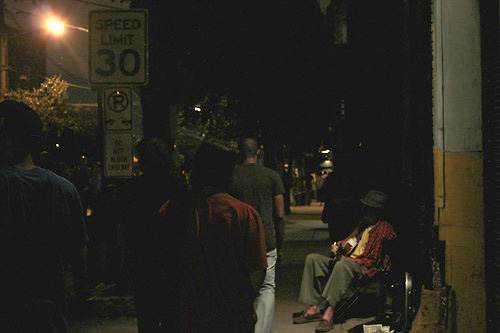
On October 5, Castleberry Hill will be transformed into a sensory playground for a dedicated group of artists to test their creative whims on a grand scale.
This playground is known as Flux Night, a collection of sights, sounds, and even smells. For one night Castleberry Hill will be flooded with twenty art installations that include dance, projections, parades, music and much more. Flux Night is hosted by the non-profit organization Flux Projects, which helps fund and ignite Atlanta’s art community.
Flux Projects came to life in 2010 as the brainchild of founder Louis Corrigan and a dedicated board of directors who have expanded the movement in the last three years. They came together with three distinct goals in mind: fund artists, find their audience, and make Atlanta a more creative place to be.
They knew that Atlanta has hosted a variety of acclaimed art exhibits for decades, but the artists were not gaining traction outside of a tightly knit group of followers. Flux Projects helped to expand that small fanbase into a community that continues to grow on its own.
Three years later, the non-profit has succeeded on all fronts by taking art outside of galleries and bringing it into the streets.
“We want [Flux Night] to be an event where it’s not just an art event, so people outside the traditional art going crowd show up and want to experience it,” Executive Director Anne Dennington said. “Though we do want to be sure that there are projects that are challenging people who are well versed in public arts.”
Dennington joined Flux Projects in 2010 after she served on the mayor’s public art adviser council in 2007 and as the first executive director of Atlanta Celebrates Photography. She has witnessed the growth of Flux Night from a nascent movement into a full blown art and street festival that includes artists not just from Atlanta but around the globe.

For art students brimming with passion but lacking an audience, Flux Night is a savior.
Though all applicants to Flux Night compete on a level playing field, student artists that do make the final cut are presented with a host of invaluable opportunities for their career.
“Time and again artists have used their flux projects to apply for residency, get projects in other cities, win awards, and receive additional funding,” Dennington says.
While classes provide students with artistic knowledge and training, events like Flux Night provide student artists with visibility, an absolutely crucial element for turning a craft into a career.
“Students benefit in two ways, on the one hand they benefit from being commissioned to do projects,” Dennington says. “On the other hand they benefit from having access to projects in their own town.”
Students artists involved in Flux Night are also offered the opportunity to network with renowned local and international artists. Even visitors gain the experience of witnessing the freedom that Flux artists have to explore their own visions.
“Our projects let artists stretch what they’ve been able to do creatively, technically, aesthetically,” Dennington says.
This year’s theme, chosen by curator Helena Reckitt, is free association. Some of the projects include a 15-foot-tall vanilla milkshake-scented fountain, a horse-drawn piano, a dance troupe guided by audience suggestions and other projects that immerse the audience in the artists’ fantastical work.
